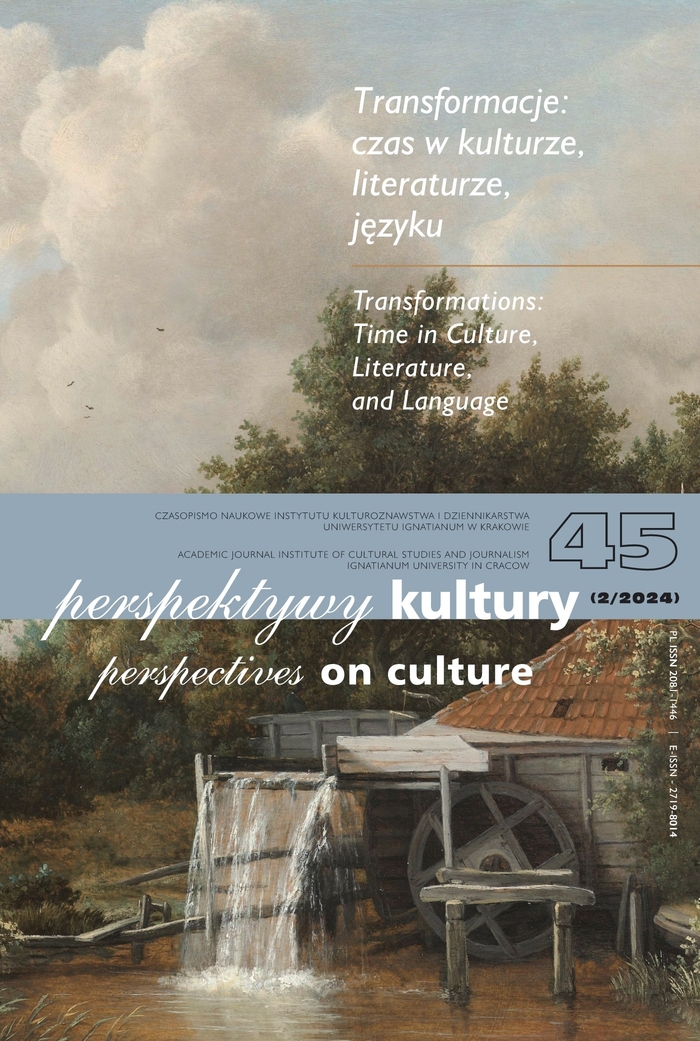Hybrid Music Practices as a Phenomenon of Contemporary Culture
Abstract
The aim of the article is to discuss the nature of hybrid musical practices related to the creation, distribution, and consumption of music, understood as a phenomenon of contemporary, globalized, and digitally mediated culture. First, music’s specificity was discussed and understood as a form of interpersonal interaction and a space for building social relations. In particular, Christopher Small’s assumptions about the interactive nature of music were emphasized. Subsequently, two great breakthroughs were outlined – analog and digital – which revolutionized the nature of human musical practices (both at the creative and reception level), leading humanity towards a contemporary hybrid and the interpenetration of what is real with what is virtual. The nature of these practices has been discussed in relation to issues such as (a) a new, hybrid “culture of the ear,” (b) new, hybrid ways of navigating the musical digital space, (c) new, hybrid contexts of experiencing music, (d) new practices related to modern streaming. The “music in the cloud” with its interactive character is currently the most popular form of consuming music content, which has been supported by available global research. In this context, contemporary phenomena and processes related – on the one hand – to the potential of streaming, and – on the other – to certain dysfunctions related to distinction and digital exclusion were shown. These issues are also embedded in the context of pandemic times, in which the whole culture, and therefore music, has moved online, generating, on the one hand, many new possibilities on the real-virtual line, but also creating a number of problems related to crossing the boundaries between what is digitally mediated and what is available in the natural contexts of creating and experiencing music. Paradoxically, the time of the Sars-CoV-2 pandemic turned out to be a kind of catalyst for contemporary culture and contemporary musical practices of people.
References
Bajakian A. (2021). Alone Together: Musicking in the Time of COVID-19, Improvisation, Musical Communities, and the COVID-19 Pandemic. Critical Studies in Improvisation., tom 14, nr 1, 1-3.
Bennet A. (2015). Music, Community, and Self. W: J. Shepherd i K. Devine (red.), The Routledge Reader on the Sociology of Music. London: Routledge, 143-152.
Cox Ch., Warner D. (red.) (2010). Kultura dźwięku: teksty o muzyce nowoczesnej. Gdańsk: Słowo/obraz terytoria.
Etzkorn K.P. (1964), Georg Simmel and the Sociology of Music. Social Forces, nr 43(1), 101-107
Holt F. (2010). The Economy of Live Music in the Digital Age. European Journal of Cultural Studies, nr 13(2), 243–261.
Jabłońska B.(2017). Muzyka-media-kultura. Kultura Współczesna, nr 3(96), 120-129.
Kofin E. (2012). Muzyka wokół nas. Studium przeobrażeń recepcji muzyki w dobie elektronicznych środków jej przekazywania. Wrocław: Wydawnictwo Uniwersytetu Wrocławskiego.
Maasø A. (2018). Music Streaming, Festivals, and the Eventization of Music. Popular Music and Society, nr 41(2), 154-175. DOI: 10.1080/03007766.2016.1231001
Morris J.W., Powers D. (2015). Control, curation and musical experience in streaming music services. Creative Industries Journal, nr 8:2, 106-122, DOI: 10.1080/17510694.2015.1090222
Nickell Ch. (2020). Promises and Pitfalls: The Two-Faced Nature of Streaming and Social Media Platforms for Beirut-Based Independent Musicians. Popular Communication, nr 18 (1), 48-64. DOI: 10.1080/15405702.2019.1637523
Nożyński Sz. (2016). Od walca z rylcem do Spotify. Dostępność muzyki a dziennikarstwo muzyczne. W: M. Parus i A. Trudzik (red.), Media jako przestrzeń muzyki. Gdańsk: Wydawnictwo Naukowe "Katedra", 81-104.
Nożyński Sz. (2017). Muzyka na żądanie – transformacje w obszarze kultury audialnej. Kultura Współczesna, nr 3/96, 99-109.
O'Hara K., Brown B. (2006). Consuming Music Together. Social and Collaborative Aspects of Music Consumption Technologies. Dordrecht: Springer.
Prensky M. (2001). Digital Natives, Digital Immigrants. On the Horizon (MCB University Press, tom 9 nr 5, 1-6.
Prior N. (2018). Popular Music, Digital Technology and Society. Los Angeles, London, New Delhi, Singapore, Washington DC, Melbourne: SAGE Publications Ltd.
Small Ch. (1998). Musicking: The Meanings of Performing and Listening. United States of America: Wesleyan University Press.
Śmigielska K. (2017). Zespoły portale jako miejsce wymiany muzycznych inspiracji w czasach kultury realnej wirtualności. Kultura Współczesna, nr 3(96), 172-181.
Strachan R. (2017). Sonic Technologies: Popular Music, Digital Culture and the Creative Process. New York: Bloomsbury Academic.
Taylor T. D. (2001). Strange Sounds: Music, Technology & Culture, New York: Routledge.
Turner J.S., Tollison A.C. (2021). The Evolving Communicative Value of Popular Music: Music Is Interpersonal Communication in the Age of Digital Media. Journal of Broadcasting & Electronic Media. nr 65 (3), 357-376, DOI: 10.1080/08838151.2021.1957893
Vandenberg F., Berghman M., Schaap J. (2020). The ‘lonelyraver’: music livestreams during COVID-19 as a hotline to collective consciousness? European Societies, 1-12.
Webster J. (2020). Taste in the platform age: music streaming services and new forms of class distinction. Information, Communication & Society, nr 23(13), 1909-1924, DOI: 10.1080/1369118X.2019.1622763
Friedlander J. P., Bass M. (2022), YEAR-END 2022 RIAA REVENUE STATISTICS. https://www.riaa.com/wp-content/uploads/2023/03/2022-Year-End-Music-Industry-Revenue-Report.pdf
Global Music Report (2023). International Federation of the Phonigraphic Industry. https://globalmusicreport.ifpi.org/
Głowacki A. (red.) (2022). Uczestnictwo w wydarzeniach kulturalnych online w trakcie pandemii, Warszawa: Narodowe Centrum Kultury. https://www.nck.pl/badania/raporty/uczestnictwo-w-kulturze-online
Copyright (c) 2024 Perspectives on Culture

This work is licensed under a Creative Commons Attribution-NoDerivatives 4.0 International License.
Autor, zgłaszając swój artykuł, wyraża zgodę na korzystanie przez Wydawnictwo Uniwersystet Ignatianum z utworu na następujących polach eksploatacji:
- utrwalania utworu w formie papierowej, a także na nośniku cyfrowym lub magnetycznym;
- zwielokrotnienia utworu dowolną techniką, bez ograniczenia ilości wydań i liczby egzemplarzy;
- rozpowszechniania utworu i jego zwielokrotnionych egzemplarzy na jakimkolwiek nośniku, w tym wprowadzenia do obrotu, sprzedaży, użyczenia, najmu;
- wprowadzenia utworu do pamięci komputera;
- rozpowszechniania utworu w sieciach informatycznych, w tym w sieci Internet;
- publicznego wykonania, wystawienia, wyświetlenia, odtworzenia oraz nadawania i reemitowania, a także publicznego udostępniania utworu w taki sposób, aby każdy mógł mieć do niego dostęp w miejscu i czasie przez siebie wybranym.
Wydawca zobowiązuje się szanować osobiste prawa autorskie do utworu.





